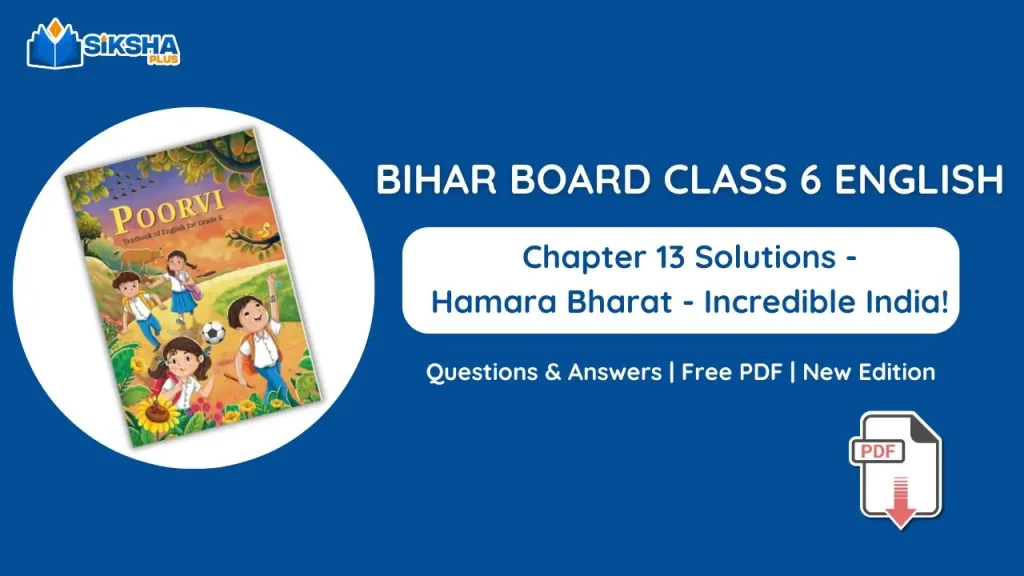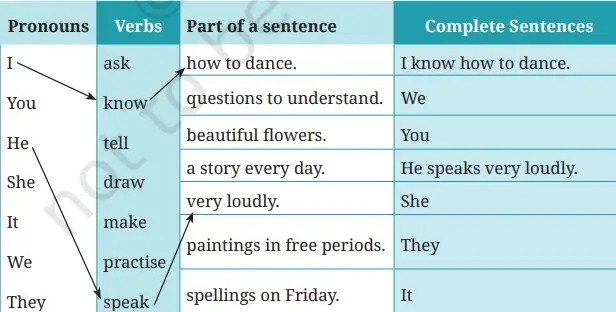New Book Bihar Board Class 6 English Chapter 13 Solutions are available here. This provides all questions and answers of chapter 13 – “Hamara Bharat – Incredible India!” for free. It follows the new English Book of Bihar Board Class 6 – Poorvi.
Chapter 13 – Hamara Bharat – Incredible India! takes us on a colorful journey across India’s diverse cultures. Through a school’s “Ek Bharat, Shreshtha Bharat” program, we meet children showcasing unique art forms – from Uttarakhand’s Aipan paintings to Odisha’s Dhokra metalwork, Kerala’s coconut crafts to Andhra’s Kondapalli toys. This chapter celebrates how India’s unity shines through its amazing cultural diversity! Below are the Bihar Board Class 6 English Chapter 13 – Hamara Bharat Question Answers to help you understand this chapter better.

Bihar Board Class 6 English Chapter 13 Solutions
Contents
| Class | 6 |
| Subject | English (Poorvi) |
| Chapter | 13. Hamara Bharat – Incredible India! |
| Board | Bihar Board |
LET US DISCUSS
From page number 132.
1. What has Bharat always been known for?
Ans: Bharat has always been known worldwide as a land of wise and brave people. Our country is famous for its smart thinkers and courageous heroes throughout history.
2. What is attractive about Bharat?
Ans: The rich and colorful culture of Bharat attracts people from all over the world. Our diverse traditions, food, clothing, festivals, and art forms make our country special and interesting to others.
3. What is special about the fact that the people live here in unison?
Ans: The special thing is that even though people in India have different languages, religions, and customs, they still live together peacefully. This shows unity in diversity, which means we are different yet united as one nation.
4. What geographical features does the passage mention?
Ans: The passage mentions many geographical features like flowing rivers, beautiful lakes, and tall mountains. It also talks about our green forests that are home to many kinds of plants, insects, birds, and animals.
5. What is the advice given to everyone?
Ans: The advice is that we all need to keep working hard to make our country Bharat grow and become even better. Each of us should do our part to help our nation progress.
ACTIVITIES BEFORE WE READ
Our country is beautiful and every state has its own uniqueness. The words given below are part of our identity. Complete these words with the correct vowels (A, E, I, O, U).
(a) We like to decorate our homes with our f _ l k _ r t.
Ans: Folk art.
(b) Our c _ l t _ r e consists of our ideas, customs, traditions, values, arts, and languages.
Ans: Culture.
(c) All of us celebrate our f _ s t _ v _ l s together.
Ans: Festivals.
(d) We tell stories to our children to teach them about our c _ l t _ r e, h _ s t _ r y, and l _ g _ n d s.
Ans: Culture, history, legends.
(e) We have our own l _ n g _ a g _ s to talk to each other.
Ans: Languages
LET US DISCUSS
From page number 133.
1. What is the Ek Bharat, Shreshtha Bharat programme all about?
Ans: Ek Bharat, Shreshtha Bharat programme is a plan started by the Indian government to bring all Indians closer together. It helps people from different states learn about each other’s culture and traditions.
2. Why is this programme being conducted?
Ans: This programme is being conducted to celebrate our country’s different cultures and help people from various states and Union Territories understand each other better. It creates friendship and unity among all Indians.
LET US DISCUSS
From page number 136.
On the basis of what the speakers said about the art forms, complete the table given below:

Ans:
| Name of the child | State | Art form | Things needed |
|---|---|---|---|
| Akanksha | Uttarakhand | Aipan | White rice flour paste |
| Priyaranjan | Odisha | Dhokra | Clay, Wax, Fire, Brass scrap |
| Chitra | Kerala | Coconut shell craft | Brown coconut shell, sandpaper |
| Balamurali | Andhra Pradesh | Kondapalli | Soft wood, Tamarind seed powder, Oil or Water colours, Vegetable dyes and Enamel paints |
LET US THINK AND REFLECT
1. Fill in the blanks to complete the following sentences.
(a) The designs for Aipan are taken from _____ and _____.
Ans: Nature, cultural traditions
(b) Dhokra metal craft is very old because it is _____ old.
Ans: 4000 year
(c) A base is needed for coconut shell craft to make it _____.
Ans: Smooth
(d) Soft wood, _____ and colours are used to make Kondapalli Toys.
Ans: Makku-a paste of tamarind seed powder, sawdust
2. Why does Akanksha’s family make Aipan?
Ans: Akanksha’s family makes Aipan because it is their traditional folk art. They create these special designs during family functions and festivals to bring good luck and celebrate important occasions.
3. In Dhokra, why does wax come out of the small openings?
Ans: In Dhokra art, they first cover the wax figure with clay and heat it in fire. The heat makes the wax melt, and it flows out through small holes made in the clay. After the wax comes out, they pour melted brass into the empty space, which takes the same shape as the wax figure.
4. What is common in the toys made in Balamurali’s village and coconut shell craft in Kerala?
Ans: Both crafts use natural materials that can break down in soil (biodegradable). Also, both are important cultural art forms that represent the traditions of their states and are passed down through generations.
LET US LEARN
1. Priyaranjan, Chitra and Balamurali share how art works of their states are made. They use some words to show the order of making it. Those words are given in the box below:
to begin, first, then, after that, next, finally, at last
How I Get Ready for School
(i) _____ I get up and go to take a shower. (ii) _____, I wear my school dress. (iii) _____, I eat my food. (iv) _____, I wear my shoes. (v) _____, I pick up my bag and go out of my home.
Ans:
(i) First
(ii) Then
(iii) After that
(iv) Next
(v) Finally
2. The children from different states each speak about one art form from their state. When they speak, they use the first form of the verb. It shows something that happens regularly. It is called the present tense. With he, she and it, -s/-es is used with the verb to show the present tense. Make five sentences with the help of the words given in the table below. Use -s/-es wherever necessary. Two examples are given.

Ans: Please try yourself.
LET US LISTEN
1. Listen to the description of gakkad bharta and complete the notes given below. (refer to page 162 for transcript)

Ans:
(a) Sushil
(b) Jabalpur
(c) Madhya Pradesh
(d) Gakkad Bharta
(e) Brinjal & Tomatoes
2. Now, listen to the description again and complete the flowchart on how to make gakkad bharta.

Ans:
- wheat, roast
- roast, chopped
- bharta
LET US SPEAK
1. Speak about a local art form of your region. It can be any one out of painting, rangoli, metal craft, embroidery, music, dance or drama. Remember to include:
- The name of the art form.
- What things do they need for it.
- How do they make/present it.
Ans: Madhubani Painting
Madhubani is a famous art form from Bihar. It is a very old style of painting that tells stories through pictures.
Artists need simple materials to make Madhubani paintings. They use natural colors from plants, flowers, and clay. They also need paper or cloth to paint on, and thin bamboo sticks or brushes.
To make a Madhubani painting, first, the artist draws the outline of the main shapes. Then, they fill these shapes with bright colors. After that, they add smaller details like flowers, animals, or people. Next, they draw patterns in the empty spaces. At last, they put a border around the whole painting.
Madhubani paintings often show nature, gods and goddesses, or scenes from daily village life. This art form has been passed down from mothers to daughters for hundreds of years.
2. You may use the words given below when you speak.
- I know about the art form called …
- They need …
- To make it, first … after that … next … then … at last …
Ans:
- I know about the art form called Warli painting. It comes from Maharashtra and is very simple but beautiful.
- They need white rice paste or paint, bamboo sticks as brushes, and brown or red background made from cow dung or mud.
- To make it, first they prepare the background by applying mud or cow dung on a wall or paper. After that, they let it dry completely. Next, they use white rice paste to draw simple stick figures showing people, animals, and daily activities. Then, they add details like trees, houses, and the sun. At last, they connect all these elements with patterns to tell a story about village life.
